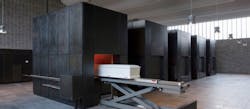Crematorium Features Industrial Mobile Control
Yep, there’s an app for that. That oft-repeated phrase can now be applied to the control of cremation ovens thanks to the integration of Opto 22’s groov with DFW Europe’s crematory control system.
Prior to founding of DFW Europe, Jan Keeman worked as a central heating and filter systems installer. He moved into building cremation systems in the early 1990s after gaining experience installing filtration systems in crematoriums to meet European standards.
The DFW Europe crematory operating system consists of two separate systems for process control and operation. The company uses Opto 22’s PAC control for these systems. According to Keeman, he chose the PAC control system because of the flexibility of the hardware and software and the lack of licensing costs for the programming and HMI software.
To win the right to design a state-of-the-art cremation installation in Ringsted, Denmark, that would use five cremation ovens, one of the requirements was that operators with smart phones could control the cremation ovens.
DFW Europe had already developed a method for scanning cremation numbers with smart phones; however a separate IR remote control was required for operating the ovens until Opto 22 groov became available, says Keeman. The fact that Opto 22 groov also communicates with non-Opto 22 hardware was a significant factor in the decision to adapt the original plan away from the separate IR control method and toward use of groov.
Using groov’s development tool with tag database, DFW Europe was able to test the set-up of their new system with groov in one morning. All that was required was to watch the training video, connect the groov box to the network and establish the connection with groov via a web browser.
“We phoned on Thursday to ask if we could try a test set-up,” says Bart Keeman, Jan’s son. “We received it Friday morning and our first groov interface was working in the test environment on Friday afternoon.”
After a short testing phase, engineers from DFW Europe were able to start programming the final user interface for the Danish crematorium. Within a couple of weeks, the engineers had fully implemented the groov screen into the production environment, permitting operators to operate the entire cremation process with a smart phone and keep an eye on the status of the oven at all times.
According to Keeman, the interface developed for this system has been kept very simple. When the coffin is inserted into the cremation oven, the operator only has to enter his name, scan the registration number of the coffin, and then press the start button. The remainder of the process is then controlled automatically.
Based on Keeman’s experience with filtration systems and European standards requirements, DFW Europe cremation ovens are recognized as being highly energy-efficient and low in emissions. Keeman notes that hundreds of homes, two schools and a swimming pool in Ringsted are heated with the recovered energy from DFW Europe’s cremation system.
About the Author
David Greenfield, editor in chief
Editor in Chief

Leaders relevant to this article:
